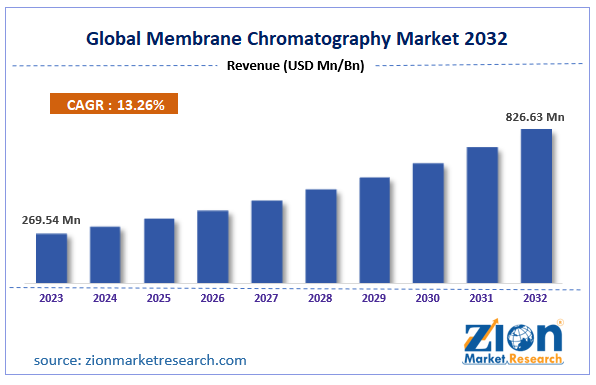Membrane Chromatography Market Trend, Share, Growth, Size and Forecast 2032
The membrane chromatography market is a specialized segment within the broader field of bioseparation technologies, focusing on the use of membrane-based systems for the purification and separation of biomolecules. Membrane chromatography offers a high-throughput, efficient, and scalable alternative to traditional column chromatography, making it increasingly popular in biopharmaceutical production and other applications. Here’s an overview of the market:

Get a Free Sample : https://www.zionmarketresearch.com/sample/membrane-chromatography-market
1. Market Overview:
- Growing Biopharmaceutical Industry: The increasing demand for biopharmaceuticals, including monoclonal antibodies, vaccines, and recombinant proteins, is a significant driver of the membrane chromatography market. These products require efficient and scalable purification processes, which membrane chromatography can provide.
- Advantages Over Traditional Chromatography: Membrane chromatography offers faster processing times, lower buffer consumption, and reduced operational costs compared to traditional column chromatography, making it an attractive option for many industries.
2. Key Applications:
- Protein Purification: Membrane chromatography is widely used for the purification of proteins, including monoclonal antibodies, which are essential in the production of biopharmaceuticals.
- Virus Removal and Capture: It is also employed in the removal and capture of viruses during the production of vaccines and gene therapies, ensuring product safety and purity.
- Plasmid DNA Purification: Membrane chromatography is increasingly used for the purification of plasmid DNA, which is crucial for gene therapy and vaccine development.
- Polishing Steps in Downstream Processing: Membrane chromatography is often used in the polishing steps of downstream processing to remove impurities such as host cell proteins, DNA, and endotoxins.
3. Market Segmentation:
- By Product Type: The market can be segmented into consumables (membranes, capsules, and cartridges) and equipment (systems and instruments).
- By Technique: Segmentation by technique includes ion exchange membrane chromatography, affinity membrane chromatography, and hydrophobic interaction membrane chromatography.
- By End-User: Key end-users include biopharmaceutical companies, contract research organizations (CROs), academic and research institutes, and others.
4. Technological Advancements:
- Development of High-Capacity Membranes: The introduction of high-capacity membranes with enhanced binding capacities and selectivity has significantly improved the efficiency and scalability of membrane chromatography.
- Integration with Automated Systems: The integration of membrane chromatography with automated systems and process analytical technologies (PAT) is enhancing process control, consistency, and scalability, particularly in large-scale biopharmaceutical manufacturing.
- Advancements in Affinity Membranes: Innovations in affinity membranes, which use specific ligands to target biomolecules, are expanding the applications of membrane chromatography in complex separations.
5. Regional Insights:
- North America: North America is a leading market for membrane chromatography, driven by the strong presence of biopharmaceutical companies, extensive R&D activities, and advanced healthcare infrastructure in the region.
- Europe: Europe also holds a significant market share, with countries like Germany, the UK, and Switzerland at the forefront of biopharmaceutical production and research.
- Asia-Pacific: The Asia-Pacific region is experiencing rapid growth, fueled by the expansion of the biopharmaceutical industry in countries like China, India, and South Korea, as well as increasing investments in biotechnology research.
6. Competitive Landscape:
- Key Players: Major players in the membrane chromatography market include Sartorius AG, Merck KGaA, Pall Corporation (a Danaher company), GE Healthcare (now Cytiva), and 3M Company. These companies are focusing on product innovation, strategic acquisitions, and partnerships to strengthen their market position.
- Emerging Companies: Several emerging companies are entering the market, offering specialized membrane chromatography products and technologies, thereby increasing competition and driving innovation.
7. Regulatory Environment:
- Compliance with Biopharmaceutical Standards: The membrane chromatography market is highly regulated, particularly in the biopharmaceutical sector, where products must meet stringent quality, safety, and efficacy standards set by regulatory bodies such as the U.S. FDA and EMA.
- Quality Control and Validation: Regulatory requirements for the validation and quality control of membrane chromatography processes are critical, ensuring that the final products are free from contaminants and meet all necessary specifications.
8. Market Challenges:
- High Initial Costs: The initial investment required for membrane chromatography systems can be high, particularly for small and medium-sized enterprises (SMEs), which may limit market growth.
- Technical Complexity: The operation and optimization of membrane chromatography systems require technical expertise, which can be a barrier for some organizations.
- Competition from Traditional Chromatography: Despite its advantages, membrane chromatography faces competition from established column chromatography methods, particularly in applications where these traditional methods are already well-optimized.
9. Future Trends:
- Continuous Bioprocessing: The adoption of continuous bioprocessing is expected to drive the demand for membrane chromatography, as it aligns well with the need for continuous and efficient downstream processing.
- Expansion of Affinity Membranes: The development and application of novel affinity membranes targeting specific biomolecules will likely expand the use of membrane chromatography in new areas of biopharmaceutical production.
- Sustainability and Green Chemistry: There is a growing focus on sustainability and green chemistry in biopharmaceutical manufacturing, which may drive the adoption of membrane chromatography due to its lower resource consumption and reduced environmental impact.
10. Impact of COVID-19:
- Increased Demand in Biopharmaceuticals: The COVID-19 pandemic has accelerated the demand for biopharmaceuticals, including vaccines and therapeutics, boosting the need for efficient purification methods such as membrane chromatography.
- Supply Chain Resilience: While the pandemic initially caused disruptions in the supply chain, the market has adapted, with a continued emphasis on ensuring reliable production and purification processes in biopharmaceutical manufacturing.
The membrane chromatography market is poised for significant growth, driven by advancements in biopharmaceutical production, the need for efficient and scalable purification technologies, and ongoing innovations in membrane technology. As the industry continues to evolve, membrane chromatography is likely to play an increasingly important role in the future of bioseparation and bioprocessing.
Contact :
US OFFICE NO +1 (302) 444-0166
US/CAN TOLL FREE +1 (855) 465-4651
Email: sales@zionmarketresearch.com
read other reports :
https://medium.com/@aiwalemaha/bone-sonometer-market-size-share-trends-growth-2032-5baa40bb99c5
https://taguas.info/?p=46692&preview=true
https://vr-zone-ferndale.mn.co/posts/64165218
https://webyourself.eu/blogs/430683/Glass-Syringe-Market-Size-Share-Trends-Growth-and-Forecast-2032
https://generalspeaks.com/?p=19224&preview=true
https://locantotech.com/microscopy-market-size-share-trends-growth-2032/



Comments
Post a Comment